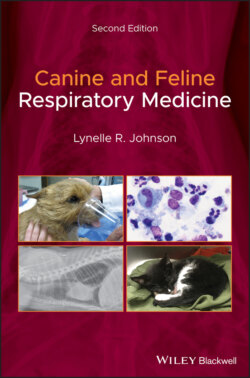Читать книгу Canine and Feline Respiratory Medicine - Lynelle Johnson R., Lynelle R. Johnson - Страница 36
Alveolar–Arterial Oxygen Gradient and PF Ratio
ОглавлениеThe alveolar–arterial (A–a) oxygen gradient estimates the difference between the calculated alveolar oxygen level expected for the animal and the measured arterial oxygen level. Thus, the A–a gradient corrects for the level of ventilation performed by the animal and allows comparison of blood gas data through the course of disease that is not impacted by the effect of an increase or a decrease in PaCO2 on PaO2. The A–a oxygen gradient is calculated as:
where FiO2 is the fraction of inspired oxygen (0.21 on room air), PB is the barometric pressure (in mmHg), PH2O is the water vapor pressure (47 mmHg at 37 °C), and R is the respiratory quotient (ratio of CO2 production to O2 consumption, usually assigned a value between 0.8 and 1.0). PaO2 and PaCO2 are obtained from blood gas analysis. Normal value for the A–a oxygen gradient is <15.
The PaO2/FiO2 ratio (PF or oxygenation ratio) provides a measure of the ability of the lung to oxygenate as the fraction of inspired oxygen changes from room air to 100% oxygen. This is calculated by dividing arterial oxygen by FiO2 (ranging from 0.21 to 1.0). Normal animals have a PF ratio of >500 at sea level. Values between 300 and 500 indicate mild impairment of oxygenation, while values <200 indicate serious decrements in oxygenation. A PF ratio <200–300 is one of the criteria for a diagnosis of acute respiratory distress syndrome.
